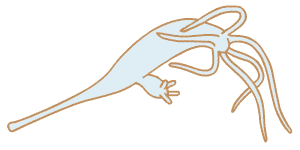|
Hydra (multicellular)
Further details: |
Name (genus): Hydra Size : 4 - 30 mm including tentacles Where to find them : Attached to surfaces like water plant stems and the undersides of floating leaves. Notes : The Hydra is a very distinctive creature with its tentacles. If a jar of pond water with some weed is left to stand for a while, the hydra - if present, may be seen by eye attached to the wall of the jar, or the vegetation. They are often pale brown or green. The underside of floating weed like duckweed is a particularly good place to find them. Hydra have many fascinating features, one in particular is that they can reproduce asexually by budding where a smaller hydra grows off the body of the adult and eventually separates. The tentacles have stinging cells which they use to capture prey like small water fleas. They are a classic organism for biology students to study as they are a representative member of the Phylum Cnidaria. The cnidarians are the most primitive animal where the cells are organised into different layers. Classification : |
